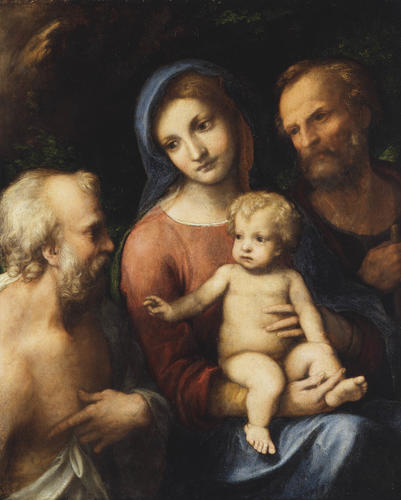The Holy Family with Saint Jerome c. 1519
Oil on poplar panel | 68.9 x 56.6 cm (support, canvas/panel/stretcher external) | RCIN 400029

Correggio (Antonio Allegri, c. 1489-1534)
The Holy Family with Saint Jerome c. 1519
-
This altarpiece is an early work probably dating from soon after Correggio left his home town of Correggio to settle in Parma, where he executed a cycle of frescoes in the Camera di San Paolo in 1518-19. It probably dates shortly after the closely related Holy Family with the Infant Baptist of c. 1518-9 (Musée des Beaux Arts, Orléans). It is likely that this painting was known to Parmigianino, who was in Parma until 1524, because he twice borrowed the idea of the left-hand saint - seen in profile, closer to the viewer than the other figures and cut off by the frame - for his Mystic Marriage of St Catherine of c.1526 (National Gallery, London) and Madonna and Child with Infant St John, the Magdalene and St Zachariah of c.1527-30 (Uffizi).
The Virgin and Child, with Joseph on the right, all gaze at the figure on the left, presumably St Jerome, who is blessed by the Christ Child. This and St Catherine Reading (RCIN 405768), both small devotional works, are the two that remain of the eight works by Correggio originally owned by Charles I. The Holy Family with the Infant Baptist now in Orléans was also in Charles’s collection. In his 1627-8 negotiations with the Gonzaga on behalf of the King, Daniel Nys mentioned a ‘Madonna of Correggio with a head of St Joseph’, which has been connected with this painting but could as well refer to the Orléans picture. The present painting has a Charles I brand but it is not in Van der Doort’s inventory, probably because it was at Greenwich for which he only made summary notes and where it was appraised at £50 in September 1649.
Correggio is known to have reused preparatory drawings or repeated ideas from earlier compositions. The group of the Virgin, Joseph and the Christ Child repeat the group in the Orléans Holy Family, although in that work they are gazing towards a figure of the young John the Baptist. The two heads of the Virgin are so close that they may derive from the same cartoon. The freer brushwork, less precise delineation of forms and treatment of landscape suggest that the Royal Collection painting was the second of the two. The fact that St Jerome, who here supplants St John, was painted more thinly suggests that he may have been treated separately and added later. The Christ Child here seems unusually serious and vulnerable; though protected by his mother’s hands, he blesses the aged figure of St Jerome with gravity and authority. Christ’s tiny hand giving blessing contrasts with Jerome’s much larger accepting hand, his golden curls with St Jerome’s white hair. The sweetness and intimacy between the figures, particularly the tender but sculptural group of the Virgin and Child, recalls Raphael, who had already explored the grouping of the Holy Family many times in Florence and Rome.
Correggio’s study of Raphael is disputed but it is usually thought that he visited Rome at about this time (c.1518-19), although the evidence is only circumstantial. If he did, he would have had opportunity to study Raphael’s recent work.
Catalogue entry adapted from The Art of Italy in the Royal Collection: Renaissance and Baroque, London, 2007Provenance
In the collection of Charles I (whose brand appears on the reverse); sold to Proctor for £50 on 3 November 1649 from the Closets at Greenwich Palace; recovered at the Restoration and listed in the King's Closet at Whitehall in 1666 (no 305)
-
Creator(s)
Acquirer(s)
-
Medium and techniques
Oil on poplar panel
Measurements
68.9 x 56.6 cm (support, canvas/panel/stretcher external)
86.0 x 73.2 x 8.2 cm (frame, external)
Other number(s)
Alternative title(s)
The Holy Family with Saint James, previously entitled









